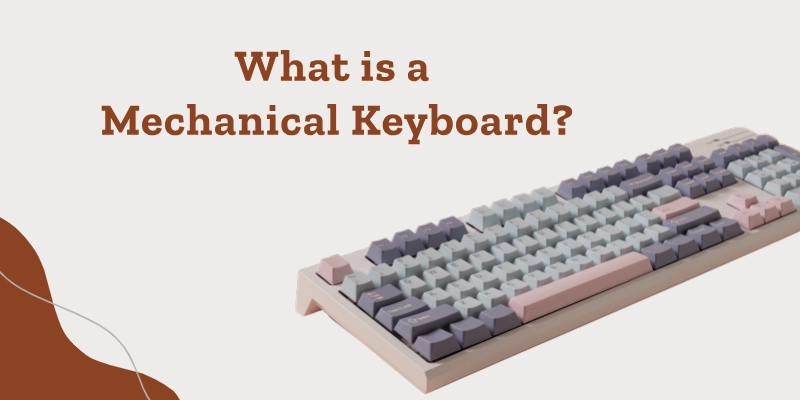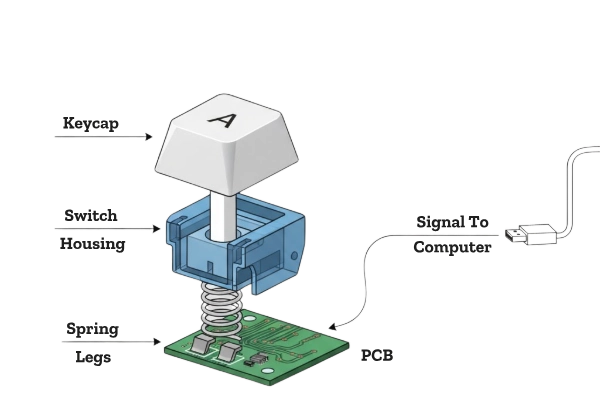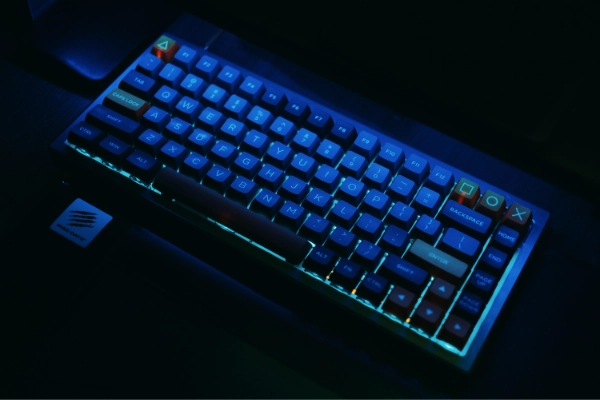What Is a Mechanical Keyboard? Find Out Why It’s Better
Published: 21 Oct 2025
Have you ever noticed the clicky sound and fast typing response of some keyboards? That’s the magic of a mechanical keyboard. These keyboards are not just ordinary ones; they are advanced input devices made for comfort, speed, and long-lasting use.
Mechanical keyboards are becoming very popular among gamers, typists, and regular computer users because they offer a smooth and satisfying typing experience.
In this article, we’ll understand what is mechanical keyboard, how it works, its main parts, different types, top benefits, and how it compares with a normal keyboard.
What is a Mechanical Keyboard?
A mechanical keyboard is a type of keyboard that uses individual mechanical switches under each key to register keystrokes.

Unlike normal keyboards that use rubber domes, these switches give a faster and more accurate typing experience. This is why many users prefer them for gaming and long typing work.
A mechanical keyboard means every key has its own spring and switch. When you press a key, it makes a clicky sound and gives a tactile feel, helping you know that the key is pressed correctly. This makes typing more enjoyable and comfortable.
Example:
Gamers, programmers, and writers often use mechanical keyboards because they respond faster, feel better, and last longer than normal keyboards. A gamer can press multiple keys at once without missing a move, and a writer can enjoy smooth, quick typing for hours.
History of Mechanical Keyboard
The history of the mechanical keyboard began with early typewriters and evolved through many designs over time. This evolution of the keyboard shows how early mechanical keyboards inspired today’s modern, durable, and comfortable models.
- The first mechanical switches were used in early typewriters.
- The IBM Model M keyboard became a famous early mechanical keyboard in the 1980s.
- Later, membrane keyboards replaced mechanical ones because they were cheaper to produce.
- Mechanical keyboards made a strong comeback for their durability, speed, and typing comfort.
- Today, they are loved by gamers, writers, and professionals for their reliable performance.
Parts of a Mechanical Keyboard
Let’s look at the main parts that make a mechanical keyboard unique and powerful. Each part works together to give that smooth, clicky, and responsive typing feel we all love.

Let’s discuss the parts of a mechanical keyboard.
- Keycaps:
The keycaps are the visible top parts that you press while typing. They are usually made of plastic, such as ABS or PBT. Keycaps are removable and replaceable, which means you can change them to customize the look or feel of your keyboard. - Switch:
The switch is the heart of every mechanical keyboard. It registers your keystrokes using springs and metal contacts. There are different types of switches, linear, tactile, and clicky, each giving a different typing experience. - Stem:
The stem connects the keycap to the switch. When you press a key, the stem moves up and down, helping the switch detect the press. The shape of the stem also decides which type of keycap fits on your keyboard. - Spring:
Inside every switch is a spring. It controls how much pressure you need to press a key and how fast it comes back up. Stronger springs need more force, while lighter ones make typing faster and easier. - Housing:
The housing is the outer shell that holds all the small parts of the switch together, including the spring, stem, and metal contacts. It keeps everything safe and helps the switch stay stable and aligned. - PCB (Printed Circuit Board):
The PCB, or Printed Circuit Board, is the main board under the switches. It connects all switches and sends electrical signals to the computer each time you press a key. Without the PCB, your keyboard couldn’t communicate with the system. - Stabilizers:
Stabilizers are found under large keys like the spacebar, shift, and enter keys. They keep these keys balanced and stable so they don’t wobble or tilt when you press them. - Backlight or RGB Lights:
Many modern mechanical keyboards have backlight or RGB lights that glow in different colors. They make the keyboard look attractive and help you type easily in the dark.
| Part Name | Function | Example |
| Keycap | The cover you press with your fingers while typing. | Letter keys |
| Switch | Registers the key press using mechanical action. | Mechanical switch |
| Stem | Connects the keycap to the switch and moves during typing. | Moves during press |
| Spring | Provides resistance and helps the key return to its place. | Inside switch |
| PCB (Printed Circuit Board) | Sends electrical signals from keys to the computer. | Electronic board |
| Stabilizer | Balances large keys and prevents wobbling. | Spacebar, Enter |
| Backlight / RGB Lights | Adds lighting effects for design and visibility. | RGB lights |
How a Mechanical Keyboard Works?
Have you ever wondered how a mechanical keyboard works when you press a key and instantly see a letter appear on your screen?
Let’s understand the working of a mechanical keyboard in a few simple steps.
- Pressing the Key
When you press a key, the keycap pushes down the stem and the spring inside the switch. - Activating the Switch
As the stem moves down, the switch connects two metal contacts. This connection is what registers your keystroke. - Sending the Signal
Once the contacts meet, an electrical signal is sent to the PCB (Printed Circuit Board). - Computer Response
The PCB immediately sends this signal to the computer, telling it which key was pressed, like “A” or “Enter.” - Returning to Position
The spring then pushes the keycap back to its original position, ready for the next press.
This simple but smart mechanical keyboard mechanism is what makes it so fast, durable, and satisfying to use. Each key works independently, which is why mechanical keyboards are known for accuracy and quick response.
Types of Mechanical Keyboards
Mechanical keyboards come in different types based on the kind of switches they use. Each switch type feels and sounds different when you press a key.
Understanding the types of mechanical keyboard switches helps you choose the one that fits your typing or gaming style best.
Based on Switch Type
Each of these switch types offers a unique experience:
- Linear switches are quick and quiet, ideal for gaming.
- Tactile switches give a light bump, helping you type accurately.
- Clicky switches make a sharp click sound for those who love the traditional typing feel.
| Switch Type | Feel / Sound | Best For |
| Linear Switches | Smooth and quiet with no bump feeling. | Gamers who want fast, silent keystrokes. |
| Tactile Switches | Slight bump with moderate sound for feedback. | Typists who like to feel each key press. |
| Clicky Switches | Loud and clicky sound with a strong bump. | Typists and keyboard enthusiasts who enjoy classic clicky feedback. |
Knowing the linear tactile clicky difference helps you pick the perfect keyboard for your needs, whether for gaming, writing, or everyday use.
Based on Size
Mechanical keyboards also come in different sizes. The size depends on how many keys the keyboard has and what it’s mainly used for. Let’s explore the popular types of mechanical keyboards based on size.
| Keyboard Type | Keys Count | Use Case |
| Full-size Keyboard | 104 keys | Best for standard office use with number pad and function keys. |
| Tenkeyless (TKL) | 87 keys | Compact and portable; ideal for saving desk space. |
| 60% Keyboard | 61 keys | Great for minimal desk setups and travel use. |
| 75% Keyboard | 84 keys | Balanced size with most keys still included. |
| Gaming Mechanical Keyboard | Extra macro keys and RGB lights | Perfect for gamers who want performance and customization. |
Each size has its own advantage. The full-size keyboard gives you all the keys, including a number pad, while the 60% keyboard is small, light, and fits easily on small desks. The full-size vs 60% keyboard difference mainly comes down to space and usage: full-size for comfort, 60% for simplicity.
Mechanical vs Membrane Keyboard
Many people wonder about the difference between a mechanical keyboard and a normal keyboard. The main difference lies in how each key works and feels when you press it.
Let’s understand this better through a clear comparison table between the two.
| Feature | Mechanical Keyboard | Membrane Keyboard |
| Working | Uses individual switches for each key. | Uses a rubber membrane layer under the keys. |
| Typing Feel | Clicky and tactile, giving physical feedback. | Soft and quiet, with no tactile bump. |
| Speed | Faster response and better accuracy. | Moderate speed, suitable for normal use. |
| Lifespan | Lasts 50–100 million keystrokes. | Lasts around 5–10 million keystrokes. |
| Price | More expensive due to the switch design. | Cheaper and easier to find. |
| Use | Best for gamers and professionals. | Common among regular users and office setups. |
The mechanical vs membrane keyboard debate mainly comes down to personal choice. Mechanical keyboards offer speed, comfort, and durability, while membrane keyboards are quieter, lighter, and more affordable.
Advantages and Disadvantages of a Mechanical Keyboard
Like every device, mechanical keyboards have both good and bad sides. Understanding the benefits and drawbacks of a mechanical keyboard helps you decide if it’s the right choice for your typing, gaming, or office needs.
| Pros | Cons |
| Durable and long-lasting, it can last up to 50–100 million keystrokes. | Expensive compared to normal membrane keyboards. |
| Better typing feel, tactile and satisfying clicky feedback. | Louder sound, which may disturb others. |
| Faster response time, ideal for gamers and fast typists. | Heavier and bulkier to carry around. |
| Customizable keycaps, switches, and lights can be changed easily. | Needs cleaning more often due to the open key design. |
| Accurate and reliable, each key works independently without ghosting. | Consumes more power if it has RGB backlights. |
Uses of a Mechanical Keyboard
The uses of a mechanical keyboard are wide and practical. These keyboards are valued for their speed, comfort, and durability, making them useful in many applications of mechanical keyboards, such as gaming, typing, office work, and creative tasks.

Here are some uses of a mechanical keyboard.
- Gaming: Mechanical keyboards provide fast key response and accurate control, making them perfect for competitive gaming.
- Typing / Programming: They offer a comfortable typing experience for long hours and help reduce mistakes while coding or writing.
- Office Work: These keyboards improve typing speed and boost overall productivity during daily office tasks.
- Design & Editing: Mechanical keyboards make using shortcuts easy and help designers or editors work more efficiently.
- Education: They are great for students learning typing or coding because of their tactile and responsive keys.
- Content Creation: Writers and bloggers enjoy smooth and consistent typing with mechanical keyboards.
- Tech Professionals: These keyboards are reliable for heavy, everyday use by professionals who spend long hours on computers.
How to Maintain a Mechanical Keyboard?
Taking good care of your keyboard helps it last longer and perform better. Let’s look at some easy keyboard maintenance tips that show how to clean a mechanical keyboard and keep it in top shape.
- Clean keycaps regularly: Gently remove dust and dirt from the keycaps using a soft brush or microfiber cloth. This keeps your keyboard clean and fresh.
- Avoid spilling liquids: Keep drinks and food away from your keyboard to prevent damage to the switches and circuit board.
- Use a keycap puller for deep cleaning: For a thorough clean, use a keycap puller to remove keycaps and clean the space underneath. You can use compressed air or a small brush to remove hidden dust.
- Store in a dust-free area: When not in use, cover or store your keyboard in a dust-free area to protect it from dirt and particles.
- Replace switches if damaged: If any switch stops working, replace it instead of the whole keyboard. This is one of the best keyboard maintenance tips to save money and keep performance strong.
Conclusion
A mechanical keyboard is designed for speed, comfort, and durability. Each key has its own switch, which makes typing smoother and more accurate. It’s popular among gamers, typists, and professionals because it offers fast response and a satisfying typing feel.
With its strong build and long life, a mechanical keyboard is perfect for anyone who spends a lot of time typing or gaming. If you want a keyboard that feels solid, lasts long, and gives you those satisfying clicks, a mechanical keyboard is a great choice.
Explore the world of mechanical keyboards and choose the one that fits your style, speed, and comfort.
FAQs
Let’s answer some common questions about mechanical keyboards below.
Press a key and listen for a clicky sound or feel a bump while typing. If each key feels separate and springy, it’s a mechanical keyboard.
Most laptops use membrane keyboards because they are thin and quiet. However, a few gaming laptops come with small mechanical switches.
Spilling liquids, dust buildup, or pressing keys too hard can damage it. Proper cleaning and care can keep it working for years.
Some gaming laptops from brands like MSI, ASUS, and Alienware use mechanical switches. These are designed for fast response and better control.
The three main switch types are linear, tactile, and clicky. Each gives a different sound and typing feel.
A full-size mechanical keyboard usually has 104 keys. Smaller versions like TKL or 60% keyboards have fewer keys for compact use.

- Be Respectful
- Stay Relevant
- Stay Positive
- True Feedback
- Encourage Discussion
- Avoid Spamming
- No Fake News
- Don't Copy-Paste
- No Personal Attacks

- Be Respectful
- Stay Relevant
- Stay Positive
- True Feedback
- Encourage Discussion
- Avoid Spamming
- No Fake News
- Don't Copy-Paste
- No Personal Attacks





